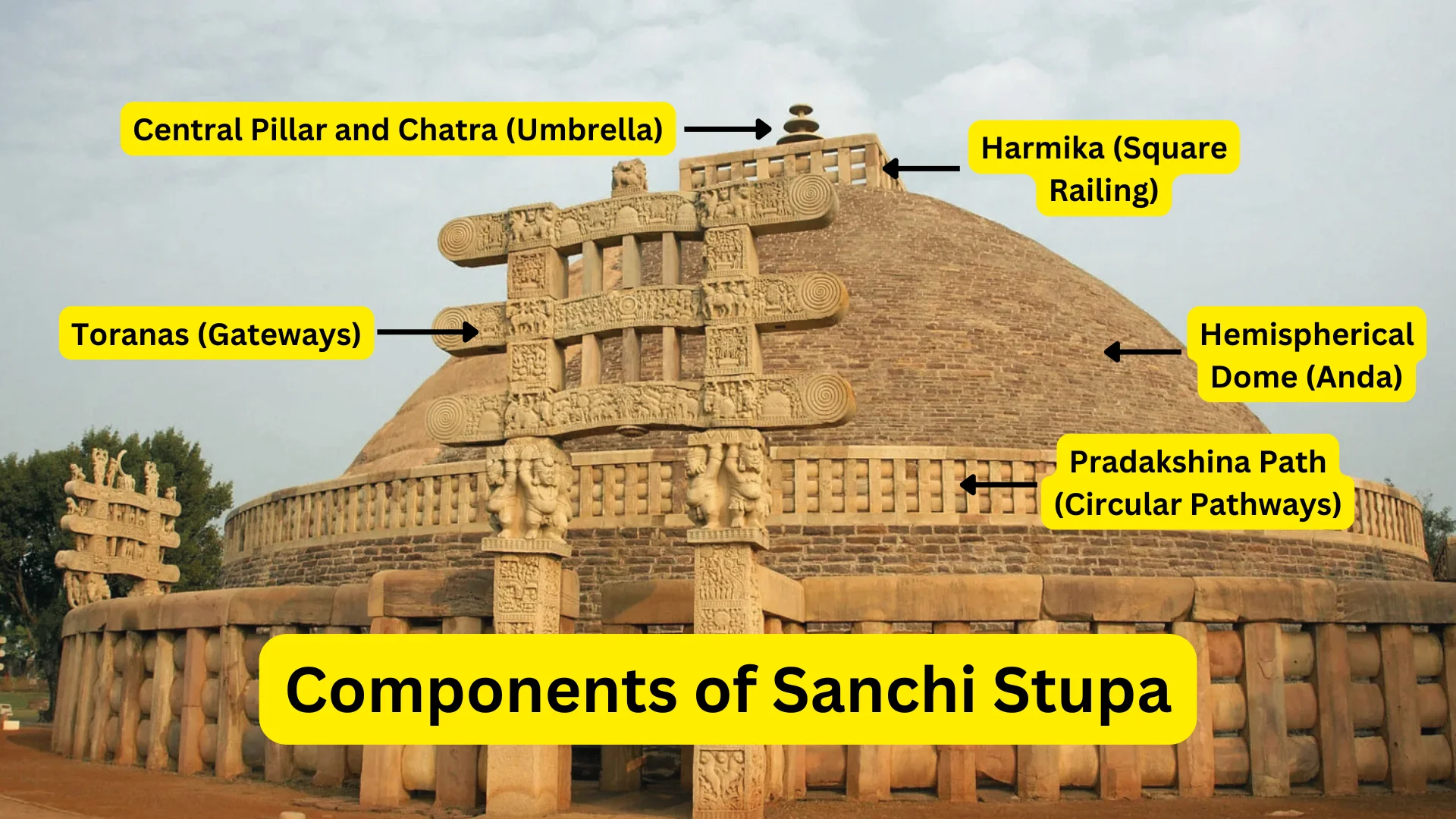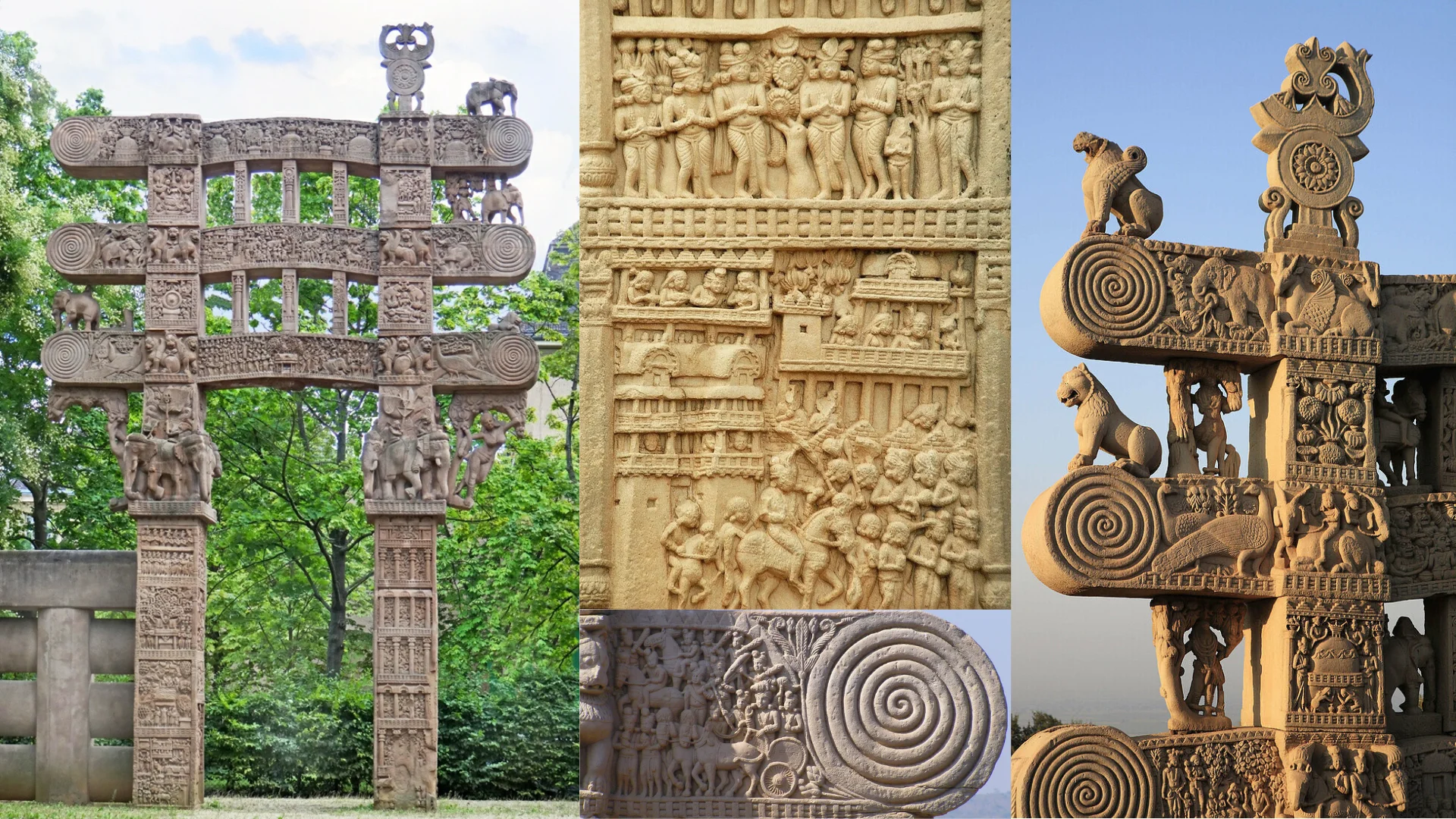Introduction
The Sanchi Stupa, located in the small town of Sanchi in Madhya Pradesh, India, is a towering testament to the enduring legacy of Buddhism. Recognized as one of the oldest stone structures in India, it is renowned not only for its architectural grandeur but also for its deep spiritual significance. Built initially in the 3rd century BCE by Emperor Ashoka, a fervent supporter of Buddhism, the stupa marks an important phase in the spread of the religion across the Indian subcontinent. In 1989, the significance of Sanchi Stupa was globally acknowledged when it was designated as a UNESCO World Heritage site. This status is attributed to its architectural innovation, historical relevance, and the cultural values it represents.
The Sanchi Stupa occupies a unique position in Indian history and Buddhist culture. Its architectural elements, including the large dome and intricately carved gateways, reflect early Buddhist symbolism and design. For centuries, Sanchi Stupa has been an emblem of peace and enlightenment, embodying the teachings of the Buddha. It continues to attract thousands of visitors every year, including historians, archaeologists, and spiritual seekers. Historians and archaeologists are drawn to the site for its insight into early Indian architecture and cultural heritage, while spiritual seekers come to connect with the serene atmosphere and rich symbolism of the stupa, which represents the cycle of life and enlightenment in Buddhism.
Historical Background
Origins and Construction
The origins of the Sanchi Stupa can be traced back to the reign of Emperor Ashoka, a pivotal figure in Indian history and Buddhism. Ashoka, who ruled from approximately 268 to 232 BCE, was once known for his military conquests, particularly the devastating Kalinga War. However, after witnessing the aftermath of war, he underwent a profound transformation, embracing Buddhism and dedicating his life to spreading the Buddha’s teachings. As part of his mission, Ashoka commissioned the construction of stupas, or mound-like structures, across India, intending to enshrine sacred relics of the Buddha and create places for meditation and reverence.

Among these, the Great Stupa at Sanchi, sometimes called Stupa No. 1, was one of the most significant. Ashoka’s choice to build the stupa in Sanchi was significant, as it was close to his wife Devi’s hometown of Vidisha, which itself held considerable cultural importance. Originally, the Sanchi Stupa was a relatively simple structure with a hemispherical dome that symbolized the mound of dirt used to cover Buddha’s remains. The simplicity of the design symbolized Ashoka’s vision of Buddhism as a straightforward path to peace and enlightenment.
Expansions and Renovations
Following Ashoka’s reign, Sanchi Stupa continued to be a site of devotion, and subsequent dynasties contributed to its expansion and embellishment. During the Shunga dynasty in the 2nd century BCE, the stupa underwent significant architectural enhancements. The Shungas enlarged the original stupa, doubling its diameter and adding a stone railing around it, which gave it a more monumental appearance. The distinctive toranas, or gateway structures, were also constructed during this period, each serving as an entrance on one of the cardinal points. These gateways are adorned with detailed carvings that depict scenes from the Buddha’s life and moral stories from the Jataka tales, which convey the Buddhist values of compassion, generosity, and self-sacrifice.
The Gupta dynasty, ruling from around the 4th to 6th centuries CE, also left their mark on Sanchi. Known for their support of arts and culture, the Guptas added more detailed sculptures and refined the artistic style of the carvings. This period is often considered a golden age of Indian culture, and the work on the stupa during this time reflects the sophistication and elegance associated with Gupta art. The contributions of these dynasties made Sanchi Stupa not only an architectural wonder but also a vibrant center of Buddhist art and narrative.
Decline and Rediscovery
As Buddhism began to decline in India between the 8th and 12th centuries, the Sanchi Stupa fell into a period of neglect. Other religions, primarily Hinduism, regained prominence in the region, leading to a gradual abandonment of Buddhist sites. The stupa, along with other Buddhist structures, suffered from natural decay and human-made destruction, and by the 14th century, it was largely forgotten, hidden beneath the layers of time.
The rediscovery of Sanchi Stupa is credited to British explorers in the early 19th century. In 1818, British General Henry Taylor stumbled upon the ruins of Sanchi, marking the beginning of a new era of preservation and archaeological interest in the site. Restoration efforts began in the late 19th century, spearheaded by Sir John Marshall, an archaeologist and Director-General of the Archaeological Survey of India. Marshall’s work was instrumental in restoring the Sanchi Stupa to its former glory, repairing its structure and preserving the integrity of its carvings.
In 1989, recognizing its global significance, UNESCO designated Sanchi Stupa a World Heritage site. This status has helped ensure the stupa’s protection and has increased awareness of its importance as a cultural and spiritual symbol. The story of Sanchi Stupa’s rediscovery and preservation underscores its enduring legacy. Today, it stands as a remarkable testament to the resilience of cultural heritage, bridging ancient and modern worlds through its timeless message of peace, enlightenment, and artistic achievement.
Architectural Significance
The Sanchi Stupa is celebrated not only for its historical significance but also for its intricate and meaningful architecture. Each feature of this structure is crafted with precision and imbued with deep spiritual symbolism, making it an enduring testament to early Buddhist art and philosophy. From the stupa’s dome to its gateways and surrounding pathways, the architectural design is a masterclass in aesthetic balance and symbolic depth, representing key Buddhist principles and offering a path for spiritual contemplation and ritualistic devotion.

Stupa Design and Structure
The central structure of the Sanchi Stupa, a hemispherical dome crowned with symbolic features, is a representation of the universe itself and a sanctuary for Buddhist teachings.
- Hemispherical Dome (Anda): The most defining feature of the Sanchi Stupa is its grand, hemispherical dome, known as the anda. This dome symbolizes the cosmos, an embodiment of the infinite nature of the universe. Constructed from brick and stone, the dome’s uniform shape and unadorned surface encourage contemplation of simplicity and unity. In Buddhist cosmology, the rounded form represents a spiritual world that transcends the confines of human life, suggesting an all-encompassing space for meditation and reflection. The dome also has practical significance, as it was designed to hold sacred relics of the Buddha, emphasizing the sanctity of the structure as a repository of spiritual energy.
- Harmika (Square Railing): The dome is capped with a square railing known as the harmika, which signifies the divine realm and serves as a boundary between the mundane and the transcendent. Positioned at the apex of the dome, the harmika symbolizes a sacred space, connecting the earthly and the divine. This architectural element draws from early Vedic structures that marked spaces of worship and dedication. In the context of the stupa, the harmika is a powerful symbol of the spiritual path, indicating a transcendental zone that represents enlightenment—a state beyond physical existence, where the individual merges with the universal.
- Central Pillar and Chatra (Umbrella): Rising from the center of the harmika is a multi-tiered chatra, or umbrella. This central pillar is a striking feature that represents the concept of Dharma, or Buddha’s teachings, which provide guidance to those on the path to enlightenment. The chatra is layered to represent the successive stages of spiritual elevation, illustrating a path of growth and ascension for the devotee. Traditionally, the umbrella has been a symbol of protection and sovereignty, with the chatra sheltering and symbolically “shading” those who seek refuge under the principles of Dharma. Thus, the central pillar is both a spiritual and architectural anchor, embodying the protective essence of Buddha’s teachings.
The Toranas (Gateways)
One of the most distinguishing features of the Sanchi Stupa are its four elaborately carved gateways, or toranas, each facing a cardinal direction and standing as a symbolic entry point for devotees.
- Representation of Cardinal Directions: The four toranas are placed in alignment with the four cardinal directions—North, South, East, and West. This positioning emphasizes the universality of Buddha’s teachings, suggesting that they are open and accessible to all people, from any direction. The four gateways also represent different stages of Buddha’s life and enlightenment journey, each one offering symbolic access to his teachings and virtues. Together, they serve as portals that guide visitors on a metaphorical journey, from mundane existence toward spiritual discovery.
- Iconography and Symbolism in Carvings: The intricate carvings on the toranas depict a wealth of symbolic iconography, primarily illustrating scenes from Buddha’s life, as well as various Jataka tales—stories of Buddha’s previous lives that impart ethical and spiritual lessons. Interestingly, Buddha is not portrayed in human form in these reliefs; instead, he is represented symbolically through images like the Bodhi tree, footprints, and the Dharmachakra (Wheel of Dharma). These representations are not merely decorative but serve to convey Buddhist teachings and inspire ethical reflection among devotees. Each carving is a masterwork of symbolism, from the lotus symbolizing purity and spiritual awakening, to the animals and mythological beings that embody virtues like compassion, courage, and wisdom.
- The Narrative Art of Jataka Tales: The Jataka tales depicted on the toranas are central to Buddhist storytelling and moral teaching. These tales, showing Buddha in various animal and human forms, are portrayed with meticulous detail, inviting visitors to learn and reflect on virtues through stories that are visually engaging and morally instructive. The narratives carved on the gateways are intended to evoke empathy, humility, and introspection among devotees, offering them practical moral guidance through the medium of visual art.
The Circular Pathways
Surrounding the central dome of the Sanchi Stupa are concentric circular pathways, known as pradakshina paths. These pathways play a fundamental role in Buddhist practice, symbolizing the cyclical nature of life and death, as well as the continuous journey towards enlightenment.
- Ritualistic Purpose of Circumambulation: The concentric pathways were constructed to facilitate the practice of pradakshina, or circumambulation. In Buddhist tradition, this ritual involves walking clockwise around a sacred object or site, symbolizing a journey in harmony with the rotation of the universe. By walking in this meditative pattern, devotees build a mindful connection with the teachings of Buddha, reflecting on the impermanent nature of existence and the path to spiritual awakening. Each step taken along these pathways is an act of reverence and devotion, connecting the devotee with the sacred relics housed within the stupa and reinforcing their commitment to the path of Dharma.
- Cultural and Spiritual Significance of the Pathways: The pathways symbolize the Buddhist concept of samsara, the cycle of birth, death, and rebirth, which devotees seek to transcend through enlightenment. Walking along the pathways is an exercise in mindfulness, encouraging practitioners to engage with each moment, observe their surroundings, and align themselves with the teachings of Buddha. As visitors progress along these pathways, they are symbolically journeying closer to the heart of the stupa—and, metaphorically, closer to the truth and wisdom that Buddha imparted. The paths allow worshippers to express their devotion physically and spiritually, making the act of circumambulation a form of active meditation that reinforces the stupa’s role as a site of pilgrimage and spiritual growth.
The architectural significance of the Sanchi Stupa is thus a harmonious blend of physical structure, philosophical symbolism, and spiritual utility. Each element—the dome, the harmika, the gateways, and the pathways—functions together to create an environment that encourages reflection, reverence, and enlightenment. The design and symbolism embedded within the stupa’s architecture make it an unparalleled example of early Buddhist art and thought, and its enduring allure is a testament to its importance as a monument of both architectural mastery and spiritual devotion.
Cultural and Spiritual Importance
The Sanchi Stupa holds profound cultural and spiritual significance, standing as an eternal beacon of Buddhist values and teachings. The monument’s symbolism transcends its physical form, offering insight into the fundamental principles of Buddhism and drawing spiritual seekers, historians, and pilgrims from around the world. Its role in the ancient Buddhist pilgrimage and the symbolic messages embedded in its design make it a sacred monument of deep religious reverence.
Symbolism of the Stupa in Buddhism
The architectural elements of the Sanchi Stupa embody the core values of Buddhism, particularly Buddha’s teachings on the nature of existence, enlightenment, and the cyclic journey of life, death, and rebirth.
- Representation of Buddha’s Teachings: The stupa symbolizes Buddha’s teachings, encapsulating the essence of the Dharma, or the path of enlightenment. The stupa’s structure acts as a three-dimensional mandala, representing the Buddha’s journey toward self-realization and liberation from suffering. The domed shape, the absence of Buddha’s physical likeness, and the symbolic elements (such as the harmika and chatra) all reflect Buddhism’s emphasis on transcendence, non-attachment, and the spiritual journey toward Nirvana.
- Nirvana and the Cycle of Life and Death: In Buddhist philosophy, the cycle of samsara (the endless loop of birth, death, and rebirth) is something to be transcended. The stupa’s form serves as a metaphor for this journey. The central dome symbolizes the world, the base represents the earthly realm, and the chatra at the top signifies Nirvana, or freedom from the cycle of suffering. Circumambulation around the stupa by pilgrims mirrors this symbolic journey, where each step brings the devotee closer to spiritual liberation.
Significance of Sanchi in Indian Buddhist Pilgrimage
The Sanchi Stupa is a vital landmark in the history of Buddhism and has served as a central pilgrimage site since ancient times.
- Ancient Center for Buddhism: Sanchi’s connection to Buddhism began during the reign of Emperor Ashoka, who, upon converting to Buddhism, commissioned the construction of stupas across his empire. Sanchi became one of the main Buddhist centers in India due to Ashoka’s patronage, which fostered the growth of monastic communities and the spread of Buddhist teachings. For centuries, Sanchi continued to serve as a learning center, where monks and devotees gathered to practice, teach, and preserve Buddhist doctrine.
- Appeal to Modern-Day Pilgrims and Tourists: Today, Sanchi’s appeal extends beyond Buddhist pilgrims to include tourists, historians, and scholars. Recognized as a UNESCO World Heritage site, Sanchi attracts those seeking to understand the depth of Buddhist art, architecture, and philosophy. The site is revered not only for its spiritual importance but also for its cultural contributions to Indian heritage. Its influence continues to inspire modern-day Buddhists, who view it as a connection to the origins of their faith and a reminder of Buddhism’s enduring legacy.
Artistic Highlights of Sanchi Stupa
The Sanchi Stupa’s artistic elements are as significant as its architectural design. The relief sculptures and carvings on the stupa are renowned for their detail, expressive iconography, and ability to convey complex stories and symbolism. Through indigenous and foreign artistic styles, the carvings depict scenes that transcend time, offering moral and spiritual teachings.
Iconography and Relief Sculptures
The stupa is adorned with intricate relief sculptures that narrate the life of the Buddha and various Jataka tales, which recount the Buddha’s previous lives in human and animal forms.

- Depictions of Buddha’s Life and Jataka Tales: The carvings on the four toranas (gateways) of the stupa present detailed scenes from the Buddha’s life, including his birth, enlightenment, first sermon, and attainment of Nirvana. Rather than direct representations, Buddha is symbolized through icons such as the Bodhi tree, empty thrones, or footprints, encouraging viewers to seek deeper understanding through symbolism. The Jataka tales depicted on the toranas are equally significant, as they provide moral teachings and exemplify virtues such as compassion, patience, and sacrifice. These stories resonate deeply with Buddhist values, highlighting the Buddha’s commitment to enlightenment across various lifetimes.
- Moral Lessons Through Visual Storytelling: Each relief panel serves as a teaching tool, presenting a story or symbol that encourages ethical reflection. The narrative art style draws in viewers, allowing them to engage with these stories on multiple levels. For pilgrims, these depictions offer spiritual guidance and are a means to reflect on the core teachings of Buddhism. For tourists, the carvings are a valuable insight into ancient Indian art and storytelling, highlighting the integration of moral teachings within visual art.
Artistic Techniques and Styles
The sculptural artistry of the Sanchi Stupa showcases a blend of indigenous craftsmanship with influences that may have arrived through cultural exchanges, creating a unique artistic expression.
- Fusion of Indigenous and Foreign Influences: The carvings reflect not only local craftsmanship but also stylistic elements influenced by Greco-Buddhist art from the Gandhara region. This fusion of artistic styles is evident in the naturalistic representations of human figures, animals, and intricate floral designs. The detailing of faces, drapery, and posture demonstrates the skill and adaptability of Indian sculptors in incorporating stylistic innovations without losing indigenous character.
- Symbolic Depictions of Nature, Flora, and Fauna: The reliefs extensively use elements of nature—trees, flowers, animals, and mythical beings—to convey spiritual meaning. The flora and fauna carved on the toranas are not merely decorative but serve as symbolic representations. Trees often symbolize enlightenment, as in the Bodhi tree, while animals like lions and elephants denote strength, wisdom, and royal power. The depiction of animals in the Jataka tales emphasizes their moral symbolism, representing virtues that are integral to Buddhist teachings. Such visual symbolism adds layers to the carvings, encouraging observers to interpret and reflect upon the interconnectedness of all beings in the pursuit of enlightenment.
Preservation and Legacy
The Sanchi Stupa, one of the oldest stone structures in India, has not only stood the test of time but continues to inspire generations with its historical, spiritual, and architectural heritage. Preserving such an ancient and sacred monument requires dedicated efforts to maintain its structural integrity, authenticity, and relevance to the cultural landscape. International and national organizations have worked together over the years to ensure that Sanchi Stupa remains a well-preserved symbol of Buddhist heritage and an influential model for architecture across Asia.
Preservation Efforts
The preservation of the Sanchi Stupa is crucial to safeguarding its historical significance and cultural legacy. Recognizing the importance of maintaining this heritage, UNESCO and the Indian government have taken a leading role in preserving the stupa for future generations.
- UNESCO’s Role in Maintenance and Preservation: Since its designation as a UNESCO World Heritage Site in 1989, Sanchi Stupa has benefited from international support aimed at preserving its architectural integrity and cultural significance. UNESCO’s involvement has provided a global spotlight on Sanchi, promoting international collaboration in heritage conservation. The organization has not only helped fund preservation efforts but also provided guidance on maintaining the monument’s authenticity. Through UNESCO’s backing, Sanchi Stupa has seen restoration projects that protect its stone structures, intricate carvings, and surrounding areas, ensuring that tourists and pilgrims alike can experience its original grandeur.
- Government Initiatives and Public Participation in Heritage Preservation: The Archaeological Survey of India (ASI) has been instrumental in preserving Sanchi Stupa, overseeing restoration work and ensuring the site is managed in line with heritage standards. Governmental projects, such as routine maintenance, stone conservation, and climate-based restoration, help protect the monument from natural and human-induced damage. Public participation has also been encouraged to foster a sense of ownership and awareness. Initiatives like heritage walks, cultural programs, and guided tours educate visitors on the historical and spiritual relevance of the stupa, while also emphasizing the need for responsible tourism and conservation.
Sanchi Stupa’s Influence on Indian Architecture
Beyond its historical and spiritual importance, Sanchi Stupa has profoundly influenced architectural practices in India and across Asia. Its form and symbolism have inspired various interpretations and adaptations in Buddhist architecture, extending its legacy to a global scale.
- Architectural Inspiration for Later Stupas and Buddhist Temples Across Asia: The architectural elements of the Sanchi Stupa, particularly its hemispherical dome, four gates (toranas), and central chatra, have served as a template for numerous stupas and temples across India, Sri Lanka, Nepal, and Southeast Asia. These structures borrow from the Sanchi Stupa’s simple yet profound design, adopting the concept of a central dome and pathways for circumambulation. The influence of Sanchi can be seen in famous stupas like the Borobudur in Indonesia and the Shwedagon Pagoda in Myanmar, which emulate its symbolic architecture, making Sanchi a pioneering force in Buddhist temple design.
- Sanchi’s Role in Inspiring Modern Interpretations of Buddhist Architecture: Sanchi’s design principles resonate with contemporary architects, who draw from its harmonious blend of spirituality and simplicity. Today, Sanchi’s architectural elements are reimagined in modern Buddhist temples and educational centers worldwide, which incorporate the stupa’s symbolic form to emphasize peace and contemplation. Many architects inspired by Sanchi’s style aim to create spaces that encourage spiritual reflection, while also paying homage to the ancient techniques and materials used in early Indian architecture.
Conclusion
The Sanchi Stupa stands as a powerful testament to India’s rich cultural heritage, embodying the essence of Buddhist philosophy, architectural skill, and historical significance. Its layered history—from its origins under Emperor Ashoka to its revered status as a pilgrimage site—reflects the deep respect this monument has garnered over generations.
More than an ancient structure, Sanchi Stupa symbolizes peace and enlightenment, tracing Buddhism’s journey across Asia. Its historical significance and architectural brilliance continue to attract historians, archaeologists, and visitors seeking a connection with ancient Buddhist art. As a UNESCO World Heritage site, the preservation of Sanchi Stupa allows future generations to learn from and appreciate its storied past.
As one of India’s earliest stupas, Sanchi embodies Buddhist values—compassion, peace, and enlightenment. Its architecture, uniting symbolic form and spiritual meaning, serves as a reminder of India’s cultural legacy and Buddhist wisdom. Heritage sites like Sanchi Stupa offer a glimpse into humanity’s shared past, reflecting ancient values and artistry. It is our responsibility to appreciate and preserve these treasures, reinforcing our link to history and the diversity of human expression. Supporting preservation ensures that monuments like Sanchi Stupa continue to educate, connect, and inspire future generations.


